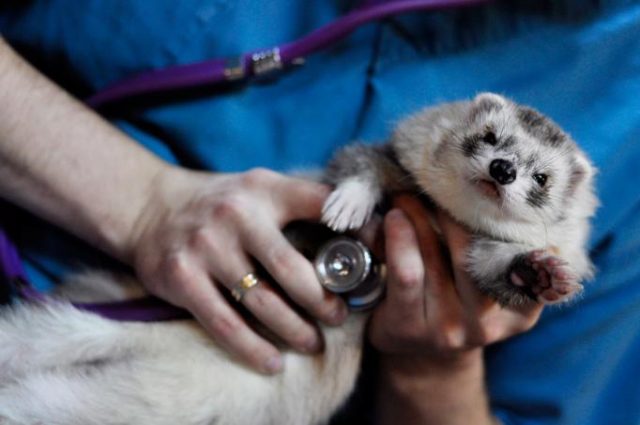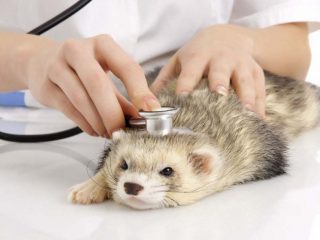Content
Domesticated ferrets, or ferrets, are very active animals whose energy and emotional behavior serve as an indicator of their physical health. Therefore, attentive pet owners immediately note when their pets show symptoms of disease. A change in behavior serves as the first warning of impending illness in ferrets.
Infectious diseases of ferrets
There are not too many infectious diseases that are characteristic of ferrets, but among them there are very dangerous ones that pose a threat not only to ferrets, but also to humans.
Rabies
Ferrets are susceptible to rabies, just like other pets. This viral disease is transmitted through contact with wild or unvaccinated domestic animals through blood or saliva and is dangerous not only for ferrets, but also for their owners.Once in the body, the virus attacks the central nervous system, causing irreversible changes in the ferret’s behavior. The disease can be latent, not manifesting itself in any way for a long time, which varies from 2 to 12 weeks. If the disease is acute, the ferret will experience the following symptoms:
- heavy salivation;
- vomiting and diarrhea;
- an increase in the ferret’s body temperature by 2 – 3 °C;
- increased aggression towards other animals, people and surrounding objects;
- hydrophobia, refusal of ferrets to drink and water procedures;
- difficulty swallowing due to paralysis of the animal’s pharynx;
- dragging of the ferret's hind limbs when moving in the later stages of the disease.
It is impossible to cure a ferret disease such as rabies. The infected animal must be euthanized. The only way to prevent the disease is timely vaccination of the ferret.
Plague
An equally serious disease in ferrets is distemper, or distemper. As with rabies, it is transmitted by wild animals, mainly predators. Often, rodents, birds, and even people can carry plague pathogens on their own clothes and the soles of their shoes. The virus of this disease enters the ferret's body through the gastrointestinal tract and begins to multiply intensively. Its incubation period is 1 - 3 weeks. After its expiration, the ferret begins to show symptoms of the disease, including:
- conjunctivitis accompanied by yellow discharge from the ferret's eyes;
- loss of appetite in animals;
- increase in ferret's body temperature to 41 - 43 °C;
- redness of the skin around the ferret's nose, lips and anus, followed by the formation of dry scabs in these places;
- diarrhea and vomiting in an animal;
- a sharp decrease in the ferret’s body weight;
- purulent discharge from the nose.
In addition to the above symptoms, ferrets exhibit a number of other disorders, which depend on the form of the disease. In total, there are 5 types of ferret plague, each of which affects certain organs:
- pulmonary;
- nervous;
- intestinal;
- cutaneous;
- mixed.
The latter variety includes signs of all designated forms of ferret disease, which appear simultaneously. Unlike rabies, plague is not dangerous to humans.
Although there is a cure for plague, 85% of cases of infection with the disease are fatal for ferrets due to their small size compared to other animals susceptible to the disease.
Distemper can be avoided by limiting the ferret's contact with suspicious animals and carrying out timely vaccination. The first vaccination against the disease is given to ferrets upon reaching the age of 8 - 9 weeks, the second - after 2 - 3 weeks. Subsequently, the procedure is repeated annually.
Flu
Paradoxically, ferrets are the only pets in existence that are susceptible to the flu. The virus of this disease can be transmitted to an animal from another ferret or even from the owner. In turn, the ferret can also infect humans with the disease virus.
Symptoms of influenza in ferrets are quite traditional, almost all of them are characteristic of people and include:
- runny nose;
- tearing eyes;
- sneezing and coughing;
- temperature increase;
- lethargy and apathy;
- loss of appetite;
- drowsiness.
Ferrets with strong immunity are able to overcome the disease virus without outside intervention within 1 - 2 weeks. If the disease is accompanied by a ferret’s complete refusal to eat and greenish loose stools, then the animal is prescribed antihistamines and antibiotics.
Salmonellosis
This fret disease is caused by paratyphoid bacteria of the genus Salmonella. The most common source of this disease is considered to be infected ferrets or food products. A ferret's risk of contracting salmonellosis is highest when eating unprocessed food, for example:
- meat;
- chicken and quail eggs;
- milk;
- water.
Salmonella poses a danger, including to humans. The peak of bacterial activity occurs in the autumn-spring period. The incubation time of the disease ranges from 3 to 21 days. Young ferrets and puppies up to 2 months of age often suffer from salmonellosis, but adults can also be infected. Moreover, in the latter, the disease is more difficult to diagnose without special tests due to the blurred clinical picture and the absence of clear symptoms of the disease.
Treatment and prevention of this disease comes down to the introduction into the body of ferrets of a special serum with antiparatyphoid properties. The serum is passed on to suckling puppies through mother's milk, so to prevent the disease, split injections should be given to pregnant and lactating females.
Infectious hepatitis
Hepatitis in ferrets is quite rare, but this acute viral disease can be very dangerous if no measures are taken to treat it for a long time.The causative agent of the disease is a virus from the Adenoviridae family, which enters the ferret’s circulatory system through the mucous membranes and causes fever, disturbances in the liver and central nervous system.
Ferret disease has 3 main stages:
- spicy;
- chronic;
- I'll tweak it.
The acute form of this disease is recognized as the most dangerous. It is characterized by symptoms such as:
- a sharp increase in temperature;
- lack of appetite;
- thirst;
- vomit;
- anemia.
This type of disease causes the ferret’s condition to deteriorate sharply, until it falls into a coma. After this, the animal dies in a matter of days if immediate measures are not taken.
The subacute form of hepatitis has the following symptoms:
- depressed state of the ferret;
- change in gait, unsteady step;
- anemia;
- yellowing of the corneas of the eyes and mouth;
- cardiopalmus;
- brown color of urine when urinating.
The chronic course of the disease is also accompanied by a change in the color of the ferret's eye membranes and some other symptoms:
- refusal to eat;
- changes in stool consistency and flatulence;
- weight loss.
Infectious hepatitis can be prevented by monitoring the movements of the ferret while walking and limiting contact with unfamiliar or wild animals. There is no treatment in the usual sense for this disease; infected animals are prescribed immunostimulants to increase the body's defenses. Ferrets recover from the disease on their own, acquiring lifelong immunity to the hepatitis virus.
Infectious jaundice, or leptospirosis
Ferrets are among a group of animals that are susceptible to leptospirosis. Animals can become infected with jaundice by eating infected rodents or through water containing the pathogen. After 3-14 days of incubation of lethospira bacteria, ferrets begin to show symptoms:
- there is a fever;
- the skin and mucous membranes of the animal’s nose, mouth and eyes turn yellow;
- Lactation of lactating ferrets stops;
- The digestive system of animals cannot cope with its functions.
Symptoms may vary depending on the course of the disease in a particular animal, but treatment is standard in all cases. A sick ferret is isolated from other living beings, including people who may also become infected. Therapy for this disease is carried out in several stages using immunoglobulins and antibiotics. For preventive purposes, vaccination against jaundice is carried out.
Aleutian disease
Aleutian disease is a viral disease that is characteristic only of animals of the Mustelidae family. It attacks the ferret’s immunity, forcing the body to intensively produce antibodies, which, not finding an infection, begin to destroy the animal’s body. The disease is transmitted from infected animals through body fluids and is extremely difficult to diagnose as it can be asymptomatic. The incubation period for the disease virus ranges from 7 to 100 days, and obvious symptoms of the disease in a ferret appear shortly before death. Among them are:
- severe weight loss in animals;
- the appearance of bleeding ulcers on the mucous membranes of the ferret's nose and mouth
- incessant thirst;
- diarrhea;
- fever;
- drowsiness;
- delayed molting;
- yellowing of the ferret's nose and paw pads.
There is no cure for Aleutian ferret disease. Symptomatic treatment of the disease will only provide a temporary reprieve for the animal.
Non-contagious diseases of ferrets
Non-contagious diseases of ferrets come in a variety of forms. Although diseases do not harm surrounding people and animals, due attention should be paid to the treatment of a sick pet, since its life may depend on it.
Avitaminosis
Vitamin deficiency, or hypovitaminosis, is a group of diseases caused by a lack of one or more vitamins in the ferret’s body. There are 2 types of disease:
- exogenous;
- endogenous.
Exogenous hypovitaminosis develops in ferrets due to a lack of nutrients in the diet or an unbalanced ratio of available vitamins. Often this disease is observed at the end of winter or early spring, since it is at this time that there is no food that will cover the need for vitamins. In this case, the situation will be corrected by proper nutrition and providing the ferret with vitamin complexes.
Endogenous vitamin deficiency occurs when nutrients are present in sufficient quantities, but they are not absorbed by the ferret’s body due to disturbances in the functioning of the digestive organs. This type of hypovitaminosis, as a rule, indicates more serious diseases and inflammatory processes in the animal's body. The disease must be treated as part of complex therapy for the animal.
Lymphomas, benign and malignant tumors
Lymphoma is a disease that is classified as a type of cancer that affects lymphoid tissue. This disease has several types, depending on the area of the ferret's body that it affects. Lymphoma is divided into:
- To multicentric, in which cancer cells affect the animal’s lymph nodes, which become greatly enlarged;
- Mediastinal. The disease affects the lymph nodes in the ferret's sternum and thymus gland, which can cause a lump to appear in the throat area;
- Gastrointestinal. The tumor develops in the animal's gastrointestinal tract;
- Extranodal. The cancer attacks the skin cells, heart and kidneys and affects the ferret's central nervous system.
Symptoms suggestive of lymphoma are common to many diseases, making it difficult to diagnose in animals. Affected ferrets exhibit:
- weakness;
- bloody diarrhea;
- vomit;
- enlarged lymph nodes;
- rarely – eye bleeding.
Unfortunately, there is currently no cure for lymphoma in ferrets. Chemotherapy and steroids can prolong the life of the animal and reduce the size of tumors, but in most cases of the disease the medical prognosis remains disappointing.
Insulinoma
Insulinoma, or hypoglycemia, is another disease common to ferrets. In insulinoma, the animal produces the hormone insulin in large quantities. The disease is associated with inflammatory processes occurring in the pancreas. It is the pancreas that is responsible for the production of this hormone, which, in turn, helps to reduce the ferret’s blood sugar levels. A drop in glucose levels leads to the following clinical picture:
- weight loss and disorientation of the ferret in space are observed;
- periods of animal apathy are replaced by activity;
- the hind legs are unsteady on the surface;
- profuse salivation and a frozen gaze of the ferret are noted;
- the animal intensively scratches its face with its front paws.
Ferrets with this disease require a special low-carbohydrate diet that contains large amounts of protein and fat. In addition, animals are prescribed therapeutic treatment for the disease using the drugs Prednisolone and Proglycema, which regulate sugar in the body.
The best alternative for treating the disease is surgery. During the operation, the very cause of the problem, namely the tumor of the ferret's pancreas, is removed, which stops the production of excess insulin. The disadvantage of this treatment lies in the fact that many tumors in the animal are very small in size and are difficult to operate on. However, the chance of the ferret returning to normal life is still quite high.
Adrenal disease
In addition to a pancreatic tumor, ferret owners may also encounter various mutations in the animal's adrenal glands - small glands responsible for the production of sex hormones.
The following symptoms indicate dysfunction of the adrenal glands:
- severe hair loss, partial baldness of the animal;
- lethargy;
- weight loss;
- increased musky ferret odor;
- weakness and cramps in the hind limbs of the animal;
- swelling of the genitals in females;
- difficulty urinating and enlarged prostate in males.
The causes of the disease include:
- genetic predisposition;
- castration of ferrets under 1 year of age;
- improper feeding.
Therapeutic treatment in the early stages of the disease allows you to balance the hormonal levels for some time and achieve good health in the ferret. However, complete recovery of the animal can only be achieved after surgery to remove the tumors.
Enterocolitis, colitis, enteritis
Enteritis and colitis are diseases of ferrets that cause inflammation of certain parts of the intestine, the small and large intestines, respectively. With enterocolitis, the mucous membranes of both parts are damaged. Bacteria that trigger inflammatory processes are not dangerous to humans or other animals, but can cause a lot of trouble for a ferret.
The key reasons that provoke the occurrence of these diseases include:
- activity of some viruses and bacteria;
- infection with certain types of helminths;
- injury to the intestinal walls;
- improper feeding.
As a result of damage to the mucous membranes, digestive processes begin to fail, which manifest themselves in the ferret’s disruption of the absorption of nutrients and water. This often leads to:
- to animal vomiting;
- problems with bowel movements;
- increased gas production in the ferret;
- an increase or decrease in the animal’s body temperature.
In most cases, when the intestines are damaged, the ferret experiences pain when palpating the abdomen; it looks lethargic and haggard. During the course of the disease, he experiences difficulty defecating; his excrement is black in color and contains unprocessed pieces of food, green or colorless mucus, and often bloody discharge.At this stage, it is necessary to begin treatment of the ferret immediately to reduce the risk of dehydration and prevent the disease from becoming chronic.
With chronic inflammatory processes in the ferret's intestines, along with the above symptoms, exhaustion, vitamin deficiency and a reduced level of hemoglobin in the blood are noted. In parallel with these diseases, disturbances occur in the functioning of other organs of the animal.
Therapeutic treatment and a gentle diet prescribed by a veterinarian are effective against these diseases.
Bronchitis, tracheitis
Bronchitis and tracheitis are diseases of the upper respiratory tract of ferrets, and are characterized by inflammation of the bronchi or trachea. Often these diseases occur in a complex manner, and then we are talking about tracheobronchitis. The reasons can be very different: from allergic reactions to infection of the animal with worms.
The main symptoms of the disease include:
- cough reminiscent of gagging;
- difficulty breathing of the animal;
- increased ferret body temperature;
- dry wheezing, turning into wet wheezing in later stages of the disease.
With proper treatment of the disease, ferrets recover quickly. The animal's recovery from illness will be accelerated significantly if standard conditions of detention are observed: proper feeding, timely vaccinations and treatment of the animal for worms.
Ear mites, otitis media
Ear mites and otitis media belong to a group of diseases that affect the ear canals of animals.These diseases are quite rare in ferrets, but the risk of infection increases if there are other pets in the house, such as raccoons, cats or dogs.
The presence of otitis is quite easy to determine visually by carefully examining the animal’s ears. So, the presence of a disease in a ferret is indicated by:
- redness of the tissues inside the ear;
- edema;
- mucous transparent discharge from the animal’s ears;
- intense scratching by the ferret of the area around the ears, up to the appearance of wounds and scratches.
Often the disease is a complication that develops when an animal is infected with an ear mite of the genus Otodectes cynotis. The appearance of this disease in ferrets is accompanied by the following symptoms, which indicate the need for immediate treatment:
- the formation of dark crusts in the animal’s ear canal, as in the photo above;
- unpleasant putrid odor of earwax;
- hair loss around the ferret's head and neck.
Upon closer inspection, you may notice small, light-colored mites scurrying around on the skin around your ferret's ears.
Prescribed by a doctor, anti-ear mite medications can help ferrets get rid of the parasites quickly. The animal treatment procedure should be carried out 1 - 2 times with an interval of 2 weeks.
Poisoning
Although various poisonings of ferrets account for 1 to 3% of all cases of seeking veterinary care, the entry of toxic substances into the body requires the same immediate treatment as salmonellosis or hepatitis.The most common type of poisoning is feed toxicoinfection, which can be caused by consuming poor-quality feed.
In case of illness, it is important to be able to provide emergency care to your ferret:
- It is necessary to stop the flow of poison into the animal’s body.
- If the poison did get in with food less than 2 hours ago, you should induce vomiting in the ferret using a solution of hydrogen peroxide and water in a 1:1 ratio. The mixture is poured into the mouth by force at the rate of 1.5 tbsp. l. for every 5 kg of animal weight.
- If more than 2 hours have passed since the poisoning, you need to rinse the ferret's stomach with a cleansing enema with cold water.
- It would not be amiss to give the animal 7 - 10 tablets of crushed activated carbon combined with petroleum jelly. The mixture is given in an amount of 3 ml per 1 kg of body weight.
- After this, the ferret must be taken to a doctor as soon as possible.
Only a qualified veterinarian can name the exact cause of an animal’s poisoning and provide optimal treatment for the disease.
Diarrhea
Diarrhea in a ferret is a sure indicator that something is wrong with the animal's body. Moreover, loose stools are a symptom of a wide range of diseases, including sometimes reporting other problems, for example:
- the presence of worms and other parasites in the animal;
- improper feeding of the ferret;
- the animal’s body does not accept new food;
- weakened ferret's immune system.
In addition, diarrhea may be a ferret’s reaction to stress when changing the environment, separation from the owner, participating in exhibitions and other situations that cause nervous tension.In case of stool problems, it is very important to examine the ferret and monitor its condition for 12 to 18 hours. If the animal does not show signs of anxiety and there are no other disturbances in its lifestyle or appearance, there is no reason to worry. In this case, a consistent diet will help improve the animal’s condition.
But prolonged diarrhea in a ferret, lasting longer than 3 days, is a fairly serious reason to contact a veterinarian, as it causes exhaustion and dehydration, which threaten the animal’s life.
Parasites
The ferret's immunity is also significantly undermined by various parasites that enter the animal's body with unprocessed food or through contact with other animals. There are 3 main groups of parasites localized in the intestines of ferrets:
- Giardia;
- cryptosporidiosis;
- coccidia.
The first 2 varieties are dangerous not only for ferrets, but also for humans, as they provoke severe diarrhea and pain in the stomach and intestines.
Ferrets with a strong immune system usually do not show any symptoms of illness and live according to their usual routine. For preventive purposes, ferrets should be dewormed once every 6 months and treated with water and food before giving it to the animals.
Inflammation of the paraanal glands
The ferret's anal glands are skin formations near the anus that secrete an odorous fluid. In healthy and strong animals, they clear themselves, but sometimes the secretion accumulates in the glands and the inflammatory process begins. The area near the ferret's anus swells, which is why the animal begins to scratch its butt on the floor and lick itself under its tail for a long time.
Some veterinary clinics perform removal of ferrets' anal glands, but very often this is not medically necessary. If inflammations occur rarely, then they can be dealt with by regular cleaning of the glands from fluid, carried out once every 3-4 months. Ferret owners can carry out cleaning at home, but the first procedure should be carried out under the supervision of a professional specialist.
Other diseases
In addition to the above-mentioned diseases, the following diseases of ferrets are considered non-contagious:
- mastitis – inflammation of the mammary glands in individuals who have given birth;
- aplastic anemia – accompanied by the release of female sex hormones, which limit the production of red and white blood cells in the ferret
- pyometra and endometritis – diseases accompanied by the accumulation of purulent discharge in the uterus;
- cataract – clouding of the lens of the ferret’s eye, leading to blindness;
- cardiomyopathy – disruption of the heart muscle of ferrets, causing heart failure;
- splenomegaly – a disease that causes an enlargement of the ferret’s spleen;
- urolithiasis disease – characterized by the formation of stones in the urinary ducts of ferrets.
Despite the fact that the diseases listed are not infectious, they can still cause significant harm to the health of ferrets, including the death of the animals, so alarming changes in their behavior should not be ignored.
In what cases should you urgently contact a veterinarian?
No matter how attached the owners are to their pets, not everyone and not always can track the slightest changes in the behavior of their beloved ferrets. Some symptoms, such as poor appetite, a one-time sneeze or short-term diarrhea, often go unattended and do not cause concern. However, individual manifestations that may seem insignificant should still make the owners wary. So, you should urgently seek veterinary help if your ferret:
- diarrhea lasts longer than 2 - 3 days;
- severe itching appears, which is not related to “fleas”;
- the color of the skin and mucous membranes of the nose, mouth, eyes and anus changes.
- weight changes sharply;
- hair loss is not associated with molting or the tip of the tail becomes bald;
- there is no playfulness and sparkle in the eyes;
- increased or decreased body temperature;
- behavior and gait changed.
Conclusion
Any diseases of ferrets in one way or another arise due to improper care, so it is important to provide the animal with the necessary living conditions. Treating your pet on your own can be no less dangerous than ignoring the symptoms, and therefore it is necessary to consult a doctor if you suspect the presence of a particular disease.


















